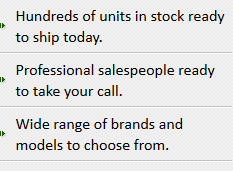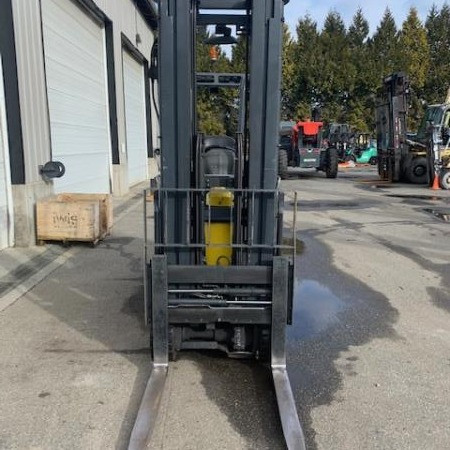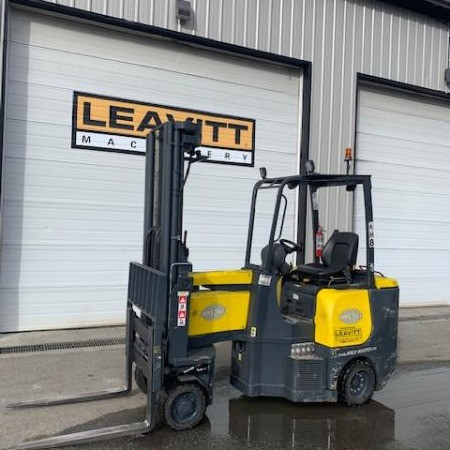Very Narrow Aisle Forklift Vallejo
Used Very Narrow Aisle Forklift Vallejo - Warehousing needs greatly focus on space-saving techniques and layout to maximize expensive square footage and decrease travel time needed to get goods from the loading docks and from point A to point B. Very narrow aisle solutions allow for more space to be dedicated to the storage of goods because less space is required for aisle access. Configuring the warehouse is known as warehouse optimization.
Warehouse Optimization
Implementing very narrow aisle warehouse optimization is a huge benefit of warehouse optimization. One of the most important benefits is the increased storage space.
Since very narrow forklift trucks have been designed to take up significantly less space, warehouse aisle widths can be reduced to half the width needed by traditional forklifts. Certain models of very narrow aisle forklifts can increase the square foot storage capabilities by delivering greater stacking heights. Costs can be drastically decreased with a narrow aisle forklift compared to a standard aisle configuration as less warehouse space is required for the same quantity of stock. Most urban locations have expensive square footage; therefore, reducing costs is a benefit to warehouses and their business. When planned carefully and properly, it is possible to increase warehouse storage area by up to 80 percent by implementing a very narrow aisle width configuration. This warehouse design creates more rack faces and increased product access. Since greater quantities of products are situated in a more accessible area, there is less travel time needed for gathering and storing items.
Very narrow aisle layouts and narrow aisle layouts are popular for warehouses. Less than eleven feet of aisle width is needed by narrow aisles. Very narrow aisles reduce the aisle width further to around six-and-a-half feet. Storage options are greatly increased with these aisle width options. Standard forklifts can have issues with turning in these aisle widths. These challenges are met by using very narrow forklifts to gain access and complete tasks.
It is necessary to know the dimensions of the aisle when selecting a forklift for a certain job. Having the right aisle dimensions will save money and time instead of purchasing the wrong forklift that won’t be able to conquer the applications. Taking note of any utilities, columns or posts is necessary before choosing a particular narrow aisle forklift design to maximize warehouse optimization and safety.
Very Narrow Aisle Forklift Trucks
Very narrow aisle forklift trucks are almost always powered electrically, usually by rechargeable battery. Stand-up riders are a popular design for very narrow aisle forklift trucks. There are different very narrow aisle forklift designs such as order pickers, reach trucks, wing-mast or turret and end-control riders.
Reach Forklift Trucks
The reach trucks were created as a type of rider stacker forklift but can be modified specifically for narrow aisle usage. This machine earned its name by its ability to reach its forks to secure a load. There are two types of reach trucks: the moving mast and the moving carriage. The moving carriage works by raising and lowering the carriage and the driver. The moving mast raises and lowers the forks as the operator remains at ground level. The moving reach truck is typically considered the safest out of the two kinds of reach trucks. Reach trucks utilize a pantograph system that is a jointed framework design enabling the driver to place and reach loads without moving the forklift.
Order Pickers
Order pickers have been created to pick items from difficult, high racking systems. They are used for smaller picking items that can be lifted and moved by hand. These order pickers work by lifting the operator up to the level of goods in order to identify and pick the specific item or items necessary to fill an order.
End-Control Riders
End-control riders can pick up loads along the floor level and transport goods horizontally instead of transporting items over heights.
Turret or Swing-Mast Forklift
The turret or swing mast very narrow aisle forklifts have a swivel mast that pivots and articulates. Pallets can be set on either the right or left side of the forklift due to the machine’s ability to use its’ swinging mast.
Guided Very Narrow Aisle Trucks
Very narrow aisle forklift trucks can be guided by rail or wire down the aisles.
Since the forklift truck is guided, the chance of colliding with racks while traversing down the aisles is very low. For rail-guided systems, a series of rails are installed into the floor, on both sides of the aisle, and run along the floor for the length of the aisle, curving around the end of the aisle. Specific wheel guides are on the forklift. These slide into the rails to stop the forklift from moving out of the rail guards.
Wire-guidance forklift systems install wires on the floor instead of rails and the wires run down the middle of the aisle. These wire-guides work along the same principle as the rail guards except that the narrow aisle forklift is fitted with a wire-guide system that allows it to communicate with the floor wires which effectively steer the forklift, preventing it from straying outside of an allotted range.
Work Site Considerations
There are a few critical considerations when implementing a very narrow aisle configuration. The floor and the rack construction needs to be evaluated to avoid any issues since the very narrow aisle units have extremely high racking systems. Four specific areas need to be perfectly prepared before a racking system can be implemented including a level floor, plumb racks, any floor cracks need to be repaired and the floor’s load capacity must be accurate. These locations need to be maintained and monitored continuously.
Level Floor
Because of the height of the racking systems, any slight slope of the floor is likely to negatively affect the plumbness of the racks, especially over time when loads are continuously placed and removed on the racks. Without this foundation of a level floor, the stability of the racks could be jeopardized.
Crack Repair
When there are floor cracks found, they need to be assessed and immediately fixed for safety concerns. The level of the floor can become unstable with cracks when they are only 3/8 inches wide. They will need to be filled properly with material as hard as the rest of the floor.
Floor Load Capacity
The floor needs to meet specific minimum requirements prior to a narrow aisle configuration. At a minimum, the floor should consist of 3,000 psi concrete as well as contain evenly distributed rebar approximately 3 to 4 inches below the surface. Depending on the load requirements and configuration, additional reinforcements may be needed.
Plumb Racks
The racking system is essential to the whole process and needs to be installed properly. There is a major chance of rack failure if improper installation occurs. All racks need to be plumb and this is one of the most vital aspects of correct installation. Rack shims are recommended to make sure the racks are plumb within one inch at the thirty- foot rack height.
If the above measures are not taken or are improperly implemented, it is likely to cause a racking failure. Racking failure can kill or injure employees, damage equipment and result in horrible damage. These measurements are vital to the success of installing a safe and productive narrow aisle configuration.
Very Narrow Aisle Forklift PDF
Stock Number: 207213 GL
Make: AISLEMASTER
Model: 44E
Year: 2013
| Stock Number |
207213 GL |
| Make |
AISLEMASTER |
| Model |
44E |
| Year |
2013 |
| Category |
Very Narrow Aisle Forklift |
Stock Number: 209213 GL
Make: AISLEMASTER
Model: 44SE
Year: 2015
| Stock Number |
209213 GL |
| Make |
AISLEMASTER |
| Model |
44SE |
| Year |
2015 |
| Category |
Very Narrow Aisle Forklift |
Stock Number: 208758 GL
Make: AISLEMASTER
Model: 44SE
Year: 2015
| Stock Number |
208758 GL |
| Make |
AISLEMASTER |
| Model |
44SE |
| Year |
2015 |
| Category |
Very Narrow Aisle Forklift |













